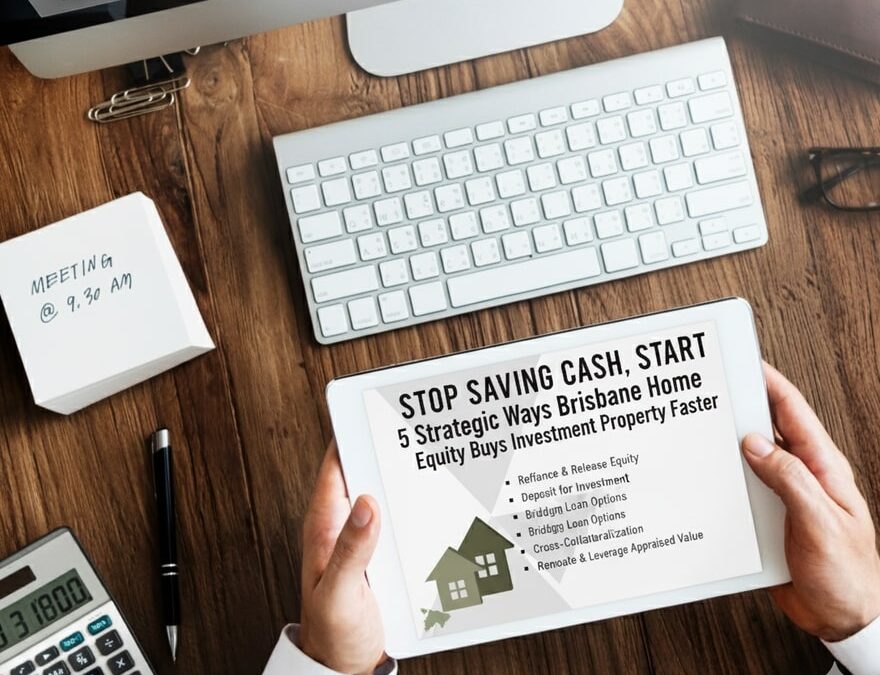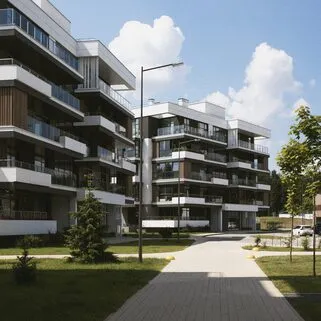You’ve been diligently saving $1,500 per month toward an investment property deposit. At this rate, you’ll have $90,000 in five years, enough for a 20% deposit on a $450,000 property. Sounds reasonable, right?
Here’s the problem: if Brisbane property prices grow at just 5% annually over those same five years, that $450,000 property will cost $574,000. Your deposit target just moved another $25,000 away. You’re not saving for a deposit, you’re chasing one.
Brisbane homeowners with existing property equity don’t have this problem. They’re buying investment properties today, not in five years, using capital that’s already working in their favour.
The Mathematics of Opportunity Cost
Let’s run the numbers on two Brisbane investors, both targeting the same investment property:
Investor A: The Cash Saver
- Saves $1,500/month for 60 months.
- Total saved: $90,000
- Property target: $450,000 (today’s price)
- Property price in 5 years (5% growth): $574,000
- Deposit required then: $115,000
- Result: Still $25,000 short, or needs to save another 17 months
Investor B: The Equity Leverages
- Uses equity from Albany Creek home (valued at $850,000, loan $400,000)
- Usable equity: $280,000
- Purchases the same $450,000 property today.
- Benefits from 5 years of rental income: ~$120,000 gross
- Benefits from capital growth: $124,000 over 5 years
- Result: Property worth $574,000, plus 5 years of rental income received
The difference? Investor B is $244,000 better off simply by using equity instead of waiting to save cash.
Strategy 1 : The Equity-Only Deposit Play
The most straightforward equity leverage strategy is using it exclusively for your deposit, while keeping your cash reserves intact for other purposes.
How It Works:
You access equity from your home to fund the full 20% deposit plus acquisition costs (stamp duty, legal fees, building inspections), then use your regular income to service the new investment loan.
Brisbane Example:
- Target property in Tingalpa: $550,000
- Required deposit (20%): $110,000.
- Stamp duty and costs: ~$22,000.
- Total equity needed: $132,000
- You access this from your home equity.
- Your $50,000 in cash savings remains untouched.
Why This Works:
- You preserve cash for emergencies and opportunities.
- You avoid the opportunity cost of slow savings.
- Your cash sits in offset account, reducing home loan interest.
- You maintain financial flexibility for renovations, rate rises, or market opportunities.
Best For:
Brisbane homeowners with strong equity positions (40%+ equity in home) who want to maintain liquidity while building their investment portfolio quickly.
Strategy 3: The Equity-Cash Hybrid Approach
Not everyone has enough equity for the full deposit, and not everyone wants to use 100% equity. The hybrid approach combines your existing equity with some cash savings for optimal flexibility.
How It Works:
Use equity to cover the majority of your deposit requirement, then top up with cash savings to reach your target LVR or preserve the equity buffer.
Brisbane Example:
- Target property in Wynnum: $620,000
- Required deposit (20%): $124,000.
- Your available equity: $90,000
- Your cash contribution: $34,000
- Stamp duty and costs funded from cash: $25,000.
Strategic Benefits:
- Reduces equity draw (preserving buffer for future opportunities)
- Demonstrates cash savings to lenders (improves serviceability assessment)
- Provides deposit security if the property valuation comes in lower than expected.
- Balances speed of acquisition with financial prudence
Best For:
First-time investors who have some savings but not enough for a full deposit, or experienced investors who want to maintain multiple funding sources.
Strategy 3: The Portfolio Multiplication Strategy
Once you’ve acquired one investment property using equity, that property itself begins building equity, which you can leverage again. This compounding effect is how Brisbane investors build substantial portfolios within 10-15 years.
How It Works:
You use your home equity to purchase Investment Property 1. After 3-5 years, Property 1 has appreciated and paid down some loan principal, creating usable equity. You then leverage equity from both your home and Property 1 to purchase Property 2, and so on.
Brisbane Example:
Year 0:
- Home in The Gap: $900,000 value, $400,000 loan ($500,000 equity)
- Use $150,000 equity to purchase Investment Property 1 in Calamvale for $600,000
Year 5:
- Home now worth $1,150,000, loan paid down to $380,000 (renewed equity: $540,000)
- Investment Property 1 now worth $765,000, loan paid down to $465,000 (new equity: $147,000)
- Combined usable equity: $687,000.
- Use $180,000 combined equity to purchase Investment Property 2 for $720,000
Year 10:
- Three properties all appreciating.
- Combined portfolio value: $3,500,000+
- Multiple equity sources for further investment
The Compounding Effect:
Each property you acquire becomes a future funding source. Your portfolio doesn’t grow linearly; it grows exponentially, with each asset contributing to the next acquisition.
Best For:
Long-term wealth builders who understand property cycles and are willing to hold properties through market fluctuations while accumulating multiple assets.
Strategy 5: The Debt Recycling Foundation
Here’s where equity leverage becomes truly sophisticated: using equity not just to acquire investment property, but to simultaneously improve your overall tax position by converting non-deductible debt into deductible debt.
How It Works:
As you pay down your home loan, you simultaneously redraw those funds to invest, maintaining your total debt level but converting the debt purpose from non-deductible (home) to tax-deductible (investment).
Brisbane Example:
- Your Hamilton home: $1,200,000 value, $600,000 home loan
- You pay an extra $3,000/month toward the home loan.
- After 12 months, you’ve paid down $36,000.
- You immediately redraw that $36,000 to invest (property deposit contribution, shares, or other investments)
- Your total debt remains $600,000, but increasingly it’s investment debt.
- Tax benefit: $36,000 × 5% interest × 37% tax rate = $666 annual tax saving
This strategy runs parallel to property acquisition and builds over the years, gradually converting your entire mortgage into tax-deductible debt.
Best For:
High-income Brisbane professionals with surplus cash flow who want to optimise tax efficiency while building investment portfolios. (Note: We’ll cover this strategy in detail in Article 5.)
Comparing Speed: Equity vs. Cash Savings
Let’s examine how quickly Brisbane investors can build a three-property portfolio using different approaches:
Cash Savings Path:
- Property 1: 5 years to save a deposit.
- Property 2: 5 years to save next deposit (10 years total)
- Property 3: 5 years to save next deposit (15 years total)
- Total time: 15 years to three properties
Equity Leverage Path:
- Property 1: Immediate (using home equity)
- Property 2: 3-5 years (using combined equity from home + Property 1)
- Property 3: 3-5 years (using combined portfolio equity)
- Total time: 6-10 years to three properties
Equity leverage cuts your portfolio-building timeline by 50% or more, and that’s before considering the additional capital growth and rental income earned by acquiring properties earlier.
The Serviceability Challenge: Turning Equity into Approval
Having equity is necessary but not sufficient; you also need to service the additional debt. Brisbane lenders assess your capacity to repay based on:
Income Requirements:
Most lenders want to see your total mortgage repayments (home plus investment) not exceed 30-35% of your gross household income at assessed rates (typically 8-9%, even if actual rates are lower).
Including Rental Income:
Lenders typically allow 70-80% of expected rental income to count toward your serviceability, acknowledging vacancy periods and property expenses.
Optimisation Strategies:
- Structure loans interest-only (reducing monthly repayments, improving serviceability)
- Use longer loan terms (30 years vs. 25 years)
- Include partner income in applications.
- Reduce discretionary spending before application.
- Consolidate or eliminate high-interest consumer debt.
A skilled mortgage broker can structure your application to maximise serviceability while maintaining financial prudence.
Risk Management: Leveraging Smartly
Using equity to buy investment property isn’t without risk. Smart Brisbane investors manage these risks through:
Maintaining LVR Buffers:
Never max out at 80% LVR across your entire portfolio. Maintain 5-10% buffers to weather market corrections or valuation fluctuations.
Cash Flow Planning:
Ensure you can service all debt commitments even if rental income drops or interest rates rise 2-3% above current levels.
Diversification:
Don’t acquire all properties in the same suburb or property type. Spread risk across Brisbane regions and property styles.
Professional Guidance:
Work with mortgage brokers, accountants, and financial planners who specialise in property investment strategy.
The Grow Well Financial Equity Leverage Framework
At Grow Well Financial, we help Brisbane homeowners transition from savers to strategic leverage through our structured approach:
- Equity Assessment: We calculate your usable equity and project future equity growth.
- Serviceability Analysis: We model your borrowing capacity and optimise your financial position.
- Strategy Selection: We match you with the equity leverage strategy that fits your goals, risk tolerance, and timeline.
- Loan Structuring: We design multi-split loan structures that maximise tax efficiency and flexibility.
- Lender Placement: We connect you with lenders who specialise in investment lending and equity leveraging.
- Ongoing Portfolio Management: We help you monitor equity positions and plan subsequent acquisitions.
Taking Action: Your 90-Day Equity Leverage Plan
Month 1: Assessment and Planning
- Week 1-2: Calculate your usable equity and borrowing capacity.
- Week 3-4: Define your investment property criteria and target suburbs.
- Consult with a Brisbane mortgage broker specialising in investment property.
Month 2: Structuring and Pre-Approval
- Week 5-6: Structure your equity access loan with optimal tax treatment
- Week 7-8: Submit pre-approval application and obtain formal approval.
Month 3: Property Search and Acquisition
- Week 9-11: Active property search with clear budget parameters
- Week 12: Make offer, subject to finance.
- Begin formal application process.
By day 90, you could be under contract on an investment property, using equity you already own rather than cash you’re still saving.
The Compound Effect: Why Waiting Costs More Than You Think
Every quarter you delay using equity is a quarter you miss:
- Rental income (approximately 4-5% gross yield annually in Brisbane)
- Capital growth (historical Brisbane average: 5-7% annually)
- Tax deductions (interest, depreciation, expenses)
- Compounding equity creation in the new asset
On a $500,000 investment property, delaying one year potentially costs you $50,000 in combined growth and rental income. The opportunity cost of waiting while you save cash can easily exceed $100,000+ over a 3–5-year period.
Ready to Stop Saving and Start Leveraging?
Contact Grow Well Financial for a comprehensive equity leverage strategy session. We’ll calculate your usable equity, model your borrowing capacity, and create a personalised action plan to acquire your next investment property using the capital you already own.
Disclaimer: This article contains general information only and does not consider your personal financial situation, needs, or objectives. Borrowing to invest in property involves risk, and you may lose money. Before making any financial decisions, you should assess whether the information is appropriate for your circumstances and consider seeking professional financial advice. Grow Well Financial is a licensed mortgage broker




